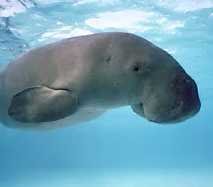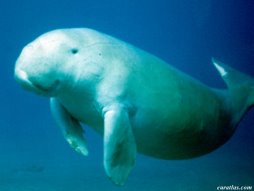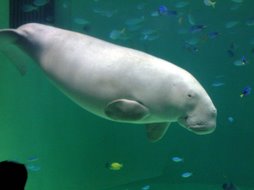Facts Of Dugong

A dugong is roughly the size and shape of a large dolphin, but with a less streamlined head and no dorsal fin. The muzzle is largeand fleshy; the eyes are small; the external ears consist only of tiny openings; and the nostrils lie close together at the anterodorsal tip of the snout. A pair of short upper incisor tusks is present, but these normally do not erupt except in adult males. The cheek teeth are simple and peglike. The neck is very short; the pectoral flippers are short and rounded, without nails; the two mammae are located in the axillae; hind limbs are completely absent; and the tail fin is horizontally flattened and in the form of flukes like those of cetaceans. The body is gray to bronze in color, somewhat lighter ventrally, and sometimes with large unpigmented areas; the thick, smooth skin is often extensively scarred in older animals.
TopFeatures of Dugong
+ Average adult length
2.7 metres (8.9 ft)
+ Average adult mass
250 to 300 kilograms (551 to 661 lb).
+ Maximum longevity (most die at a younger age)
70 years
+ Pre-reproductive period (females)
6-17 years
+ Pre-reproductive period (males)
4-16 years
+ Gestation period
13-15 months
+ Litter size
1cm
+ Lactation length
14-18 months
+ Calving interval
3-7 years
+ Maximum possible rate of increase (e.g. low natural mortality & no human-induced mortality) ~ 5% per year
+ Estimated natural mortality rate
~ 5% per year
+ Needs for survival
Fresh & warm water (Zero cold water tolerance)
Seagrass
Dugong list of facts is made of finely balanced population parameters.
Being a marine herbivorous mammal, dugongs are more closely related to elephants than to marine mammals such as whales and dolphins, but their closest living aquatic relatives are the manatees.
The dugong (Dugong dugon) is the only living herbivorous mammal that is strictly marine, and the only species of the Family Dugongidae; following the 18th century extinction of Steller's sea cow (Hydrodamalis gigas). Together with the extant of Family Trichechidae, which are the three species of manatee, forms the Order Sirenia. All extant members of the Order Sirenia are listed as vulnerable to extinction.
The Dugongidae differ from the Trichechidae in the shape of the skull and the shape of the tail. Dugongs have a forked tail, similar in shape to a whale's, while manatees' tails are paddle-shaped. Dugongs are generally smaller than manatees (with the exception of the Amazonian Manatee), reaching an average adult length of 2.7 metres (8.9 ft) and mss of 250 to 300 kilograms (551 to 661 lb).
TopHabitat
Dugongs swim in the shallow coastal waters were they find protection from large waves and storms. Dugongs surface only to breathe, and never come on to land. They like to live in large herds, but due to declining numbers are often now found in smaller "family" groups of between 1 and 3 Dugongs
TopDiet
Dugongs are particular about their diets, with certain 'fields' of sea-grass cropped. Dugongs are referred to as 'sea cows' because their diet consists mainly of sea-grass. Unlike manatees, dugongs are exclusively benthic feeders. The muscular snouts of dugongs are more dramatically tapered than those of manatees. Their primary feeding mechanism is uprooting sea-grass by digging furrows in the sea-floor with their snouts. Dugongs in Moreton Bay, Australia are omnivorous since they choose to eat invertebrates such as polychaetes when the supply of their choice grasses decreases.
They will also go to any fresh water sources for drinking. Without these fresh water sources, many would not survive. The amount of these fresh water sources, however, are beginning to decline. The dugong population is predicted to enter a steep decline. However, many scientists are working to prevent this potentially cataclysmic blow to the entire dugong population. Currently, this effort is proving futile, as the dugong population is not showing any increased population numbers.
TopBreeding
Like their relatives, the manatees of the Americas, female dugongs in season, attract the attention of a number of males, one or two of which will eventually mate with her. One young is born after a gestation period of 12-14 months and will continue to suckle from the mother for about 18 months. They may remain with the female for a number of years, as she will not calve again for periods of between 2.5 to 7 years. This low reproductive rate has implications for their conservation worldwide and leaves them vulnerable to dramatic declines due to the impact of human activities.
TopDefence
Dugongs are slow-moving and have little protection against predators. Being large animals, however, only large sharks, Saltwater Crocodiles and Killer Whales are a danger to them.
Dugong (Sea Cow) Males have ivory tusks used for fighting during male-male rivalry as well for uprooting seagrasses. Young Dugongs hide behind their mothers when in danger.
TopMigration
During the winter, a few packs of dugongs will move to warmer places in the northern countries, such as bays and canals and other will also go to man built radiators for warmth. Dugongs also live in warmer waters of many other countries near the Equator.
Top











